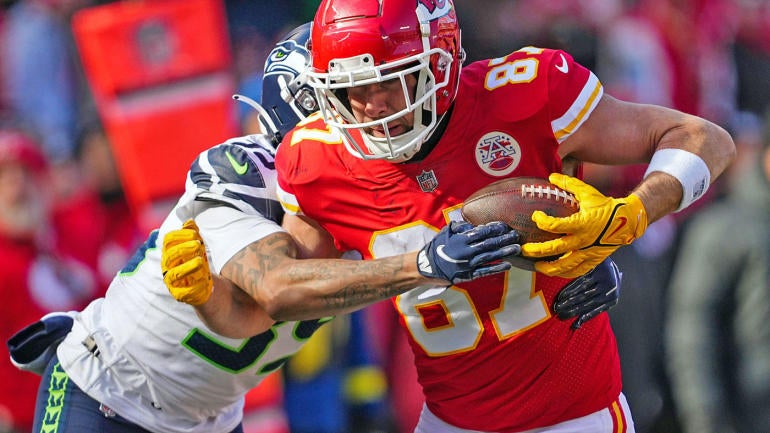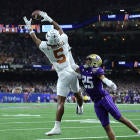
The work of a Fantasy league commissioner is thankless. Where else would you find a "job" meant to keep people from acting selfishly or foolishly while fielding complaints from whiners on a regular basis, all without a paycheck?
Worse yet, commissioners had to make some tough decisions after Week 17. Usually those kinds of choices don't happen often, but making sure your league runs shenanigan-free is part of the deal. So too is making your league as fun as possible and making sure it doesn't get stale.
With the 2022 regular season complete, I thought now would be a good time to get some fresh Fantasy concepts into the minds of league bosses everywhere. Most of it is pretty easy, straight-forward stuff that can be handled on any web platform you play on (including CBS Sports, of course). Some of it might make you scoff, but it's at least worth a read. If you're a commish, please consider them all. If you're not a commish, put this article in front of your commish and make him/her read it. Or, become a commish yourself.
Concepts are listed in order of "easiest to implement" to "yeah right buddy, no way my league will go for this ... I think."
Concept No. 1: IR spots should be universal
Jameson Williams with a Touchdown 🤩🔥
— Alabama DieHards (@DiehardsAlabama) December 11, 2022
Welcome back 🥲❤️pic.twitter.com/yFey3La4zf
The NFL expanded Injured Reserve rules during the Covid-19 pandemic and never looked back. But they did tweak them -- only eight players can come off of IR for each team during a season.
The whole point of Fantasy is to mimic player and roster management, so there really isn't a good reason to NOT have IR spots available in every league. These spaces allow Fantasy managers to hang on to their hurt players without spending a traditional bench spot to do so. Anywhere from two to five is fine.
Just make sure your leaguemates use IR spots properly. Yes, you will find the savvy ones using IR to stash players who are actually on Injured Reserve. People who drafted Jameson Williams last August did exactly that. That's part of the game and shouldn't be frowned upon. Most league hosting sites will not let you make changes to a lineup until all players ineligible for IR are reconciled. So long as folks aren't abusing the privilege, IR spots should be allowed.
Concept No. 2: Reward offensive fumble recoveries for touchdowns
“JUST LIKE THEY DREW IT UP!!”
— NFL on CBS 🏈 (@NFLonCBS) November 27, 2022
Ian Eagle calls a WILD @Titans TD, featuring a Derrick Henry fumble and then a Treylon Burks recovery in the end zone ✍️🤣
📺 CBS | Paramount+pic.twitter.com/MGcyKBgxA6
Maybe two or three times a year, a player will fumble the ball into the end zone where it's recovered by a teammate. When it happens there are instant questions about whether or not it should count for Fantasy.
The answer is simple: All touchdowns should count.
Almost every league website host has the ability to count what's called "offensive fumble recoveries for touchdowns." It's so easy for a commissioner to find the setting, check the box, and go on with their lives. And no Fantasy manager should vent frustrations over such scoring. Touchdowns are pretty random to begin with -- these are just really, really random. And rare. So let them count.
Concept No. 3: Use two flex spots
Deebo Samuel with the 13-yard touchdown run! #49erspic.twitter.com/YLPbfEyXzv
— Coach Yac 🗣 (@Coach_Yac) December 11, 2022
Cordarrelle Patterson lined up as a wide receiver on 11.6% of his snaps this season. Chig Okonkwo lined up in the backfield on 11.9% of his snaps. Deebo Samuel lined up in the backfield on 14.3% of his snaps.
Clever teams are using their best players in creative ways. Why shouldn't Fantasy managers have the chance to get creative with their lineups too?
On CBS Sports, the most common starting lineup requirement last year was one quarterback, two running backs, two wide receivers, one tight end and one flex (a RB, WR or TE), plus a DST and a kicker. I think the Fantasy experience would improve greatly if you used two flexes instead of one.
By moving into two flexes, Fantasy managers would have more, ahem, flexibility with their lineups. They could start as many as four wideouts, or four running backs, or three tight ends. Obviously, there are pros and cons as to which of these specific builds you'd lean toward, and obviously, league scoring would matter too, but the point is that it would de-prioritize any one specific position on Draft Day and also make the weekly waiver claim process a lot more interesting and a lot less frustrating.
Ultimately, using two flex spots would mean a person could use his or her best players without as much restriction.
Concept No. 4: Ditch waivers, use FAB
sports, showtime, money, boxing, cash, make it rain, mayweather, floyd mayweather, shosports, throwing money #Gif pic.twitter.com/C9OAXflqjX
— Fun with Gifs (@Trending_Gifs) June 14, 2017
One of the more recent (and most popular) improvements in Fantasy leagues is the creation of blind-bidding for free agents, which also goes by the acronym FAB (free-agent budget). It works like eBay, except with fictional dollars to win players to your fictional team. Instead of setting your waivers based on whatever order your league uses, you make bids for players. If your bid is the highest, you get the player.
This evens out the playing field when it comes to add/drops -- the worst teams aren't rewarded with preferential treatment to available players, and the boldest teams get the players they want the most. There's additional strategy to it too -- if a manager blows through his dollars, he's not going to get free agents later in the year, whereas thrifty spenders will have a better chance at the big-ticket breakouts in the second-half of the season.
Concept No. 5: De-emphasize full-PPR
Really bad drive by Vikes lost a lot yards due to penalties by oline
— Go Dawgs🔴⚫️⚪️ (@Jukejuke99) September 15, 2021
Even here they look bad both wr look back on a screen pass pic.twitter.com/gFrNrz257J
We've gotten to a point where rewarding receptions has become a little silly. A quarterback drops back and throws a quick strike to a receiver who catches it but gets tackled for a loss. Somehow, that catch is worth the same as a running back getting 10 yards?!
And what about this: When a running back scores on the ground, it's six points. When a receiver catches a touchdown, it's seven. Six for the touchdown, one point for catching the ball. Don't get me started on bonuses for a certain amount of receptions or TE-premium scoring.
Yes, catching the ball is an integral part of football. And yep, anything that adds more points to a Fantasy score is fun. But the over-emphasis on receptions has gamed Fantasy Football in a way that overshadows everything else. Chris Godwin clawed his way to three touchdowns and barely topped 1,000 yards, but because he caught 104 passes he finished FIFTEENTH in PPR points per game!
We've had a lot of discussions at the office about how to counter full-PPR. (Yeah that's right, we have an office and we talk Fantasy there! We even have a board room where we can sit down and discuss trades and add/drops! It's not bad.) Here are some ideas:
- downgrade to half-PPR
- reward something more meaningful than a catch: add a full point per first down (rushing or receiving only)
- use a mix of both of the above: half-PPR and 0.5 points per first down (h/t @HeathCummingsSr)
- start rewarding a full-point per catch after a certain amount of catches
Please note: In no way am I saying to ditch PPR entirely, though I am indeed saying that Fantasy is a little more challenging if you do.
Concept No. 6: When Kelce retires, the TE position retires too
One of the highlights of the streak came on TNF in Week 15, when Mahomes threw for 406 yards and @tkelce scored the walk-off TD in OT. pic.twitter.com/4royb0bA6E
— NFL (@NFL) January 15, 2022
One thing that is NOT universal across the NFL is how tight ends are used. Some teams barely use tight ends. Others, like the Chiefs, make them a focal point. Most teams are in the middle -- they use tight ends, but aren't typical No. 1 target-getters.
You've got time to think about this one, but the gist is that whenever Travis Kelce decides to hang 'em up, Fantasy leagues drop the TE spot from lineups. Tight ends could count as flexes only, or even as wide receivers, but they'd go the way of the dinosaur, the VCR and the Wildcat offense.
We've heard from leagues who have already ditched the tight end position and lumped those guys in with wide receivers. Kelce remains a stud obviously, but once you get past the eight or so notable tight ends, there's no interest. Why force Fantasy managers to wedge inferior players into their lineups and create such an edge for the handful of folks who have a productive tight end?
Concept No. 7: The mulligan
We've all been there: You start a player who ends up getting hurt early on or is surprisingly benched, leaving your lineup with a donut hole. Your chances of winning sink and you're forced to endure a tough loss. That's part of Fantasy Football. But it doesn't have to be.
For this idea, imagine that you get one chance to fix a mistake. You can take a player from your bench and put him into your lineup as an instant replacement.
Sound crazy? For sure. It completely goes against the basic tenets of Fantasy Football. But it would also add another incredible layer to the decisions you make as a manager. And obviously, this is something real coaches in the NFL get to do in the course of a game.
How often would you get a mulligan? Glad you asked. Some options:
- One per week. You can do it, but then so too can your opponent, and you would know that possibility before you make your change. It's only fair, after all, that your opponent gets to make a substitution too.
- One per four weeks. You can do it one week, but not for the next four weeks.
- One per season. Finally, you get to use a "One-time!"
The strategies vary for each one, but one thing's for sure: You should NOT be allowed to take a mulligan once a player on your team is in the fourth quarter, and you certainly should NOT be allowed to take a mulligan on a Monday. It should be an in-the-moment type of thing, done via a smartphone app.
Got any other interesting league-scoring changes that the world should know about? I'm all ears (or eyes in this case). Shoot em over on Twitter @daverichard or via email drichard@cbs.com.




















